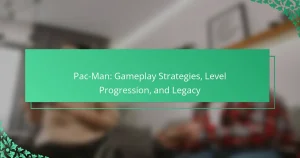Tetris offers a unique blend of puzzle mechanics and competitive play that challenges players’ cognitive skills. The game’s mechanics involve manipulating falling blocks to clear lines, while competitive environments enhance strategy and community. Psychological effects include improved spatial awareness and reduced anxiety, making Tetris a compelling experience. Understanding these elements can elevate both gameplay and enjoyment.

What are the fundamental mechanics of Tetris?
Tetris mechanics revolve around the manipulation of falling blocks to complete horizontal lines. Players rotate and position tetrominoes to fit them together, clearing lines and earning points. The game speeds up as players progress, increasing difficulty. Unique attributes include the well-known T-spin maneuver, which allows for strategic line clears. The psychological effects of Tetris involve improved spatial awareness and cognitive flexibility, making it a compelling and engaging experience.
How do Tetris pieces interact with the game grid?
Tetris pieces interact with the game grid by fitting into available spaces, creating complete lines that disappear. Each piece, known as a tetromino, has a unique shape and rotation, allowing varied placements. As pieces stack, they create challenges in managing space and preventing gaps. Effective placement maximizes line clears and enhances game strategy.
What scoring systems are used in Tetris?
Tetris uses various scoring systems, including points for clearing lines, Tetrises, and combos. Each scoring method encourages strategic play and affects competitive outcomes.
Points are awarded based on the number of lines cleared simultaneously, with bonuses for clearing multiple lines at once. A Tetris, which involves clearing four lines at once, yields the highest score. Combos occur when players clear lines consecutively without any intervening moves, further enhancing their score.
Additionally, modern Tetris games often incorporate multipliers and special bonuses, rewarding players for skillful play. These scoring systems contribute to the game’s depth, influencing player strategies and competitive dynamics.
Which strategies enhance gameplay performance?
Effective strategies to enhance Tetris gameplay performance include mastering piece rotation, optimizing placement, and maintaining a clear board. Focus on developing quick decision-making skills and practicing patterns to improve speed and efficiency. Regularly analyzing gameplay can identify weaknesses and areas for improvement.

How does competitive play shape the Tetris community?
Competitive play significantly shapes the Tetris community by fostering skill development and collaboration. Players engage in tournaments, enhancing their strategies and techniques. This competitive environment cultivates a sense of belonging, as players share experiences and knowledge. Additionally, the psychological effects of competition can motivate players to improve their performance, driving innovation in gameplay. The community thrives on these interactions, making competitive play a vital aspect of Tetris culture.
What are the key tournaments and events in Tetris history?
Key tournaments and events have shaped Tetris history, including the Classic Tetris World Championships, Tetris World Championships, and the Tetris 99 Grand Prix. These events highlight competitive play and community engagement. The Classic Tetris World Championships began in 2010, focusing on NES Tetris. Tetris World Championships, first held in 1990, showcased various Tetris versions. Tetris 99 Grand Prix, launched in 2019, introduced battle royale elements, attracting a new generation of players. These tournaments emphasize skill, strategy, and the psychological effects of competitive gaming, enhancing Tetris’s global appeal.
How do player rankings and matchmaking work?
Player rankings and matchmaking in Tetris depend on skill levels and performance metrics. Rankings are determined through competitive play, where players earn points based on their match outcomes. Matchmaking uses these rankings to create balanced matches, ensuring players face opponents of similar skill levels. This system enhances the competitive experience and maintains player engagement. Unique attributes, like individual play styles and strategies, can also influence match outcomes, adding depth to the competitive landscape.
What role do online platforms play in competitive Tetris?
Online platforms are crucial for competitive Tetris as they provide a space for players to connect, compete, and improve their skills. These platforms host tournaments, facilitate matchmaking, and offer training tools. The accessibility of online play allows for a diverse player base, enhancing competition. Additionally, platforms often feature leaderboards and rankings, motivating players to refine their strategies and techniques.

What psychological effects does playing Tetris have on individuals?
Playing Tetris can lead to various psychological effects, including improved cognitive skills, enhanced mood, and reduced anxiety. Research indicates that engaging with the game’s puzzle mechanics boosts problem-solving abilities and spatial awareness. Furthermore, competitive play in Tetris fosters social interaction, contributing to a sense of community and belonging. Notably, players often experience a phenomenon known as the “Tetris effect,” where they visualize Tetris shapes in real life, illustrating the game’s impact on cognitive processing.
How does Tetris influence cognitive skills and problem-solving?
Tetris enhances cognitive skills and problem-solving through its engaging mechanics and competitive nature. Players develop spatial awareness, improve reaction times, and enhance strategic thinking. Research shows that regular play can lead to increased brain efficiency and improved task-switching abilities. The game’s requirement for quick decision-making fosters adaptability, a key skill in problem-solving scenarios.
What are the emotional responses associated with Tetris gameplay?
Tetris gameplay elicits a range of emotional responses, including enjoyment, frustration, and satisfaction. Players often experience a sense of accomplishment when clearing lines and progressing through levels. The game’s competitive aspects can lead to excitement and motivation, while the challenge may also induce stress or anxiety. As players improve their skills, feelings of mastery and confidence typically increase. These psychological effects contribute to Tetris’s enduring popularity and its impact on cognitive function and emotional well-being.
How can Tetris be used as a tool for stress relief?
Tetris can effectively relieve stress by promoting focus and providing a sense of accomplishment. The game’s puzzle mechanics engage players in a flow state, distracting them from stressors. Additionally, the competitive aspect fosters social interaction, which can enhance mood. The unique attribute of Tetris is its ability to improve cognitive flexibility, making it a valuable tool for mental well-being.

Which unique attributes make Tetris stand out among puzzle games?
Tetris stands out due to its unique attributes like simplicity, strategic depth, and addictive gameplay. The game’s mechanics encourage quick decision-making, fostering a sense of urgency and satisfaction. Its competitive play aspect, including tournaments, adds a social dimension, enhancing engagement. Psychologically, Tetris promotes flow and can improve spatial awareness, making it a compelling experience beyond traditional puzzle games.
What innovations have been introduced in different Tetris versions?
Tetris has evolved significantly with various innovations across its versions. Key advancements include new game modes, enhanced graphics, and unique mechanics.
The introduction of multiplayer modes, such as Tetris 99, allows competitive play against numerous opponents, enhancing engagement. The “hold” feature, present in many versions, enables players to save a tetromino for later use, adding strategic depth.
Graphics have advanced from simple blocks to vibrant 3D visuals, creating immersive experiences. Additionally, the implementation of different gameplay styles, like puzzle challenges and timed modes, diversifies player engagement.
Unique attributes, such as themed versions like Tetris Effect, introduce music synchronization and visual effects that respond to gameplay, providing a novel sensory experience.
How does Tetris adapt to various platforms and devices?
Tetris adapts seamlessly to various platforms and devices by optimizing its mechanics for each environment. The game maintains its core puzzle mechanics while adjusting controls and graphics to fit mobile, console, and PC interfaces.
Different versions of Tetris utilize unique attributes like touch controls for mobile devices, traditional controllers for consoles, and keyboard inputs for PCs. This flexibility ensures that players can enjoy the game regardless of their platform.
Tetris also incorporates competitive play features on online platforms, allowing for multiplayer experiences across devices. Adaptations include leaderboards and tournaments that enhance engagement and community interaction.
Finally, the psychological effects of Tetris, such as improved spatial skills and stress relief, remain consistent across all adaptations, reinforcing the game’s appeal to a broad audience.

What challenges do players face in mastering Tetris?
Players face various challenges in mastering Tetris, including spatial awareness, speed, and decision-making under pressure. The game requires quick thinking to place tetrominoes efficiently, which can lead to stress. Additionally, players must develop strategies to manage the increasing difficulty and maintain focus. Mastery involves balancing these elements while adapting to unique game scenarios.
What common mistakes do new players make?
New players often make several common mistakes in Tetris that hinder their performance. These include poor piece placement, neglecting to clear lines consistently, and failing to plan ahead for upcoming pieces.
Additionally, many beginners focus on scoring rather than maintaining a manageable stack of blocks. This can lead to overwhelming situations where quick decisions become necessary, often resulting in errors. Lastly, not utilizing the hold function effectively can prevent players from maximizing their strategic options during gameplay.
How can players overcome skill plateaus in Tetris?
Players can overcome skill plateaus in Tetris by adopting targeted strategies. Focus on practicing specific techniques, such as T-spins and combos, to enhance gameplay. Analyzing replays helps identify mistakes and areas for improvement. Setting measurable goals keeps players motivated and engaged. Additionally, participating in community challenges fosters skill development through competition and collaboration.
What are the long-term effects of regular Tetris play on skills?
Regular Tetris play enhances cognitive skills, spatial awareness, and problem-solving abilities over the long term. Studies show improved visual processing speed and increased attention span among players. Additionally, regular engagement can foster better multitasking skills and enhance memory retention. The unique attribute of Tetris is its ability to boost mental flexibility, allowing players to adapt strategies quickly. As a result, players often experience heightened creativity in other areas of life.

How can players optimize their Tetris experience?
To optimize their Tetris experience, players should focus on mastering control techniques, understanding piece rotation, and developing a strategic mindset. Practicing these skills enhances performance and enjoyment.
One effective method is to learn the Tetris “T-spin” technique, which allows players to clear lines more efficiently. Another key strategy involves maintaining a clean stack to avoid game-ending situations. Players should also familiarize themselves with the “hold” feature, enabling better planning for incoming pieces.
Regular practice can improve reaction time and decision-making under pressure. Engaging in competitive play, whether online or in local tournaments, fosters skill development and provides valuable feedback from opponents. Additionally, analyzing gameplay through replays can highlight areas for improvement.
Lastly, managing stress and maintaining focus during gameplay can significantly enhance the overall experience. Players should take breaks to avoid fatigue and keep a positive mindset while playing.
What best practices should players follow for improved performance?
To improve performance in Tetris, players should focus on mastering piece placement, developing speed, and maintaining mental clarity. Prioritizing these strategies enhances gameplay and competitive success.
1. Practice efficient piece stacking to create solid foundations and minimize gaps.
2. Increase speed through timed drills, enhancing reaction times.
3. Use visualization techniques to anticipate upcoming pieces and plan moves.
4. Regularly analyze gameplay to identify areas for improvement.
Which resources are recommended for learning advanced techniques?
To learn advanced techniques in Tetris, consider the following resources.
1. “Tetris: The Games People Play” by David Levy – This book explores competitive strategies and psychological aspects of Tetris.
2. Tetris Friends Online – A platform for practicing against other players, enhancing competitive skills.
3. “The Tetris Effect: The Game That Hypnotized the World” – A documentary that delves into the psychological effects of Tetris.
4. YouTube Channels like “Tetris 99 Guides” – These channels offer tutorials and advanced strategies for competitive play.
5. Discord Communities – Joining Tetris-focused Discord servers can provide real-time tips and community support.
How can community engagement enhance the Tetris experience?
Community engagement significantly enhances the Tetris experience by fostering collaboration and competition among players. Engaging with others allows players to share strategies, tips, and personal achievements, enriching their gameplay.
Social interactions can lead to the formation of communities that host tournaments, increasing motivation and enjoyment. These competitive environments stimulate players to improve their skills, as they strive to outperform peers.
Moreover, community feedback can influence game development, ensuring that player preferences shape future updates. This connection between developers and the community enhances player satisfaction and loyalty.
Ultimately, community engagement cultivates a sense of belonging, making the Tetris experience more enjoyable and immersive.


